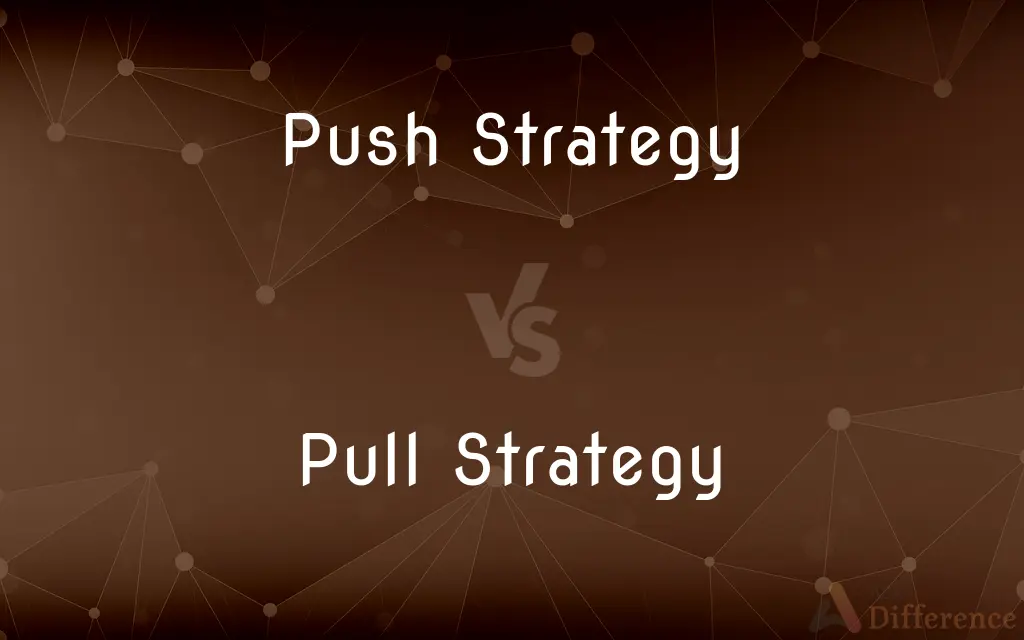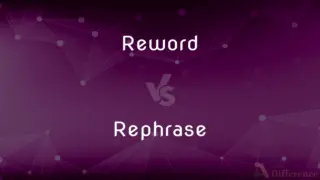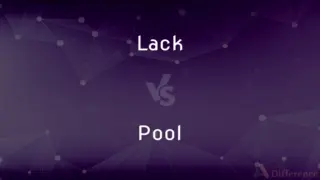Push Strategy vs. Pull Strategy — What's the Difference?
By Tayyaba Rehman — Published on September 29, 2023
Push Strategy promotes products to distributors, making them available to consumers. Pull Strategy motivates consumers to seek out a brand or product, creating demand from retailers.

Difference Between Push Strategy and Pull Strategy
Table of Contents
ADVERTISEMENT
Key Differences
Push Strategy and Pull Strategy are two contrasting approaches used in marketing to move products through distribution channels. Push Strategy involves promoting products directly to the next party in the distribution channel, typically wholesalers or retailers, thereby "pushing" the product down the chain until it reaches the consumer.
On the other hand, Pull Strategy aims to create demand directly among end consumers. By building brand recognition and consumer demand using advertising, promotions, and other forms of exposure, Pull Strategy "pulls" the product through the distribution channel as retailers respond to consumer demand.
Push Strategy primarily focuses on the immediate sale of a product. This means efforts are channeled into promoting the product to businesses in the distribution channel rather than the end consumer. As a result, there's a direct relationship between the producer and the distributor.
In contrast, Pull Strategy establishes a direct relationship between the producer and the end consumer. By building brand loyalty or product desire, consumers request or seek out the product, compelling retailers to stock the particular item.
In essence, while Push Strategy targets intermediaries in the supply chain to promote a product, Pull Strategy targets end consumers, aiming to build awareness and demand.
ADVERTISEMENT
Comparison Chart
Target Audience
Distributors, retailers
End consumers
Relationship
Producer to distributor
Producer to consumer
Demand Origin
Generated at supply chain level
Generated at consumer level
Promotional Focus
Trade promotions, discounts
Advertising, consumer promotions
Dependency
On intermediaries' willingness to stock
On consumers' desire for the product
Compare with Definitions
Push Strategy
Relying on supply chain partners to move products to consumers.
With a strong Push Strategy, they ensured their new product was prominently displayed in stores.
Pull Strategy
Building brand or product desire among consumers.
Their celebrity endorsements were a Pull Strategy to drive brand preference.
Push Strategy
A method where businesses promote products to wholesalers or retailers.
The manufacturer used a Push Strategy by offering volume discounts to big retailers.
Pull Strategy
Marketing that targets end consumers to drive product demand.
Offering limited-time consumer discounts was part of their Pull Strategy.
Push Strategy
Marketing that "pushes" products down the distribution channel.
By incentivizing distributors, their Push Strategy ensured wide product availability.
Pull Strategy
Creating consumer demand to "pull" products through the supply chain.
Their ad campaign was a successful Pull Strategy, leading many to ask retailers for the product.
Push Strategy
Incentivizing retailers to stock and sell a product.
Their Push Strategy involved providing retailers with exclusive promotions.
Pull Strategy
Generating consumer demand that retailers respond to by stocking the product.
Due to the effective Pull Strategy, even local stores started carrying the product.
Push Strategy
Direct promotion and sale to intermediaries rather than consumers.
They focused their Push Strategy on showcasing products at trade shows.
Pull Strategy
Relying on consumers to seek out and buy a product.
The buzz around the product's benefits was a calculated Pull Strategy.
Common Curiosities
When might a business use a Push Strategy?
When launching a new product or when needing quick distribution through retailers.
Why is Pull Strategy important for brand building?
It directly engages consumers, building brand recognition and loyalty.
Which strategy is more focused on advertising?
Pull Strategy primarily utilizes advertising to reach end consumers.
What tools are common in a Pull Strategy?
Advertising, public relations, and social media campaigns.
How can a business measure the success of their Pull Strategy?
By tracking increases in brand awareness, consumer demand, and sales figures.
How does Pull Strategy benefit consumers?
It builds brand awareness and product demand directly for consumers.
What's the main difference between Push Strategy and Pull Strategy?
Push Strategy targets intermediaries like retailers, while Pull Strategy targets end consumers.
Which strategy relies more on consumer behavior?
Pull Strategy, as it focuses on creating consumer demand.
Can both strategies be used together?
Yes, many businesses use a mix of both strategies for comprehensive marketing.
How do discounts fit into these strategies?
For Push Strategy, they might be volume or early-bird discounts for retailers; in Pull Strategy, they're often consumer-facing promotions.
How does Push Strategy affect retailers?
It often involves incentives or promotions to encourage retailers to stock a product.
Are there risks with using only a Push Strategy?
Yes, if consumers aren't aware or interested, products may remain unsold at retailers.
How do trade shows fit into these strategies?
Trade shows often align with Push Strategy, targeting industry members rather than consumers.
Can a product move from a Push Strategy to a Pull Strategy over time?
Yes, initial push efforts can later transition to pull as brand recognition grows.
In which strategy would influencer marketing be most effective?
Pull Strategy, as it aims to create demand among end consumers.
Share Your Discovery

Previous Comparison
Reword vs. Rephrase
Next Comparison
Lack vs. PoolAuthor Spotlight
Written by
Tayyaba RehmanTayyaba Rehman is a distinguished writer, currently serving as a primary contributor to askdifference.com. As a researcher in semantics and etymology, Tayyaba's passion for the complexity of languages and their distinctions has found a perfect home on the platform. Tayyaba delves into the intricacies of language, distinguishing between commonly confused words and phrases, thereby providing clarity for readers worldwide.













































